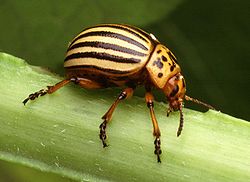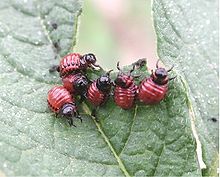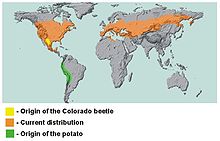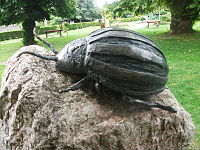- Colorado potato beetle
-
- "Potato beetle" redirects here. This can also refer to similar Chrysomelidae, e.g. Lema trilineata.
Colorado potato beetle 
Scientific classification Kingdom: Animalia Phylum: Arthropoda Class: Insecta Order: Coleoptera Suborder: Polyphaga Family: Chrysomelidae Genus: Leptinotarsa Species: L. decemlineata Binomial name Leptinotarsa decemlineata
Say, 1824[1]The Colorado potato beetle (Leptinotarsa decemlineata), also known as the Colorado beetle, the ten-striped spearman, the ten-lined potato beetle or the potato bug, is an important pest of potato crops. It is approximately 10 mm (0.4 inch) long, with a bright yellow/orange body and five bold brown stripes along the length of each of its elytra. It can easily be confused with its close cousin and look-alike, the false potato beetle.
Contents
History
The beetle was described in 1824 by Thomas Say from specimens collected in the Rocky Mountains on buffalo-bur, Solanum rostratum. The origin of the beetle is somewhat unclear, but it seems that Colorado and Mexico are a part of its native distribution in southwestern North America.[2] In about 1840, the species adopted the cultivated potato into its host range and it rapidly became a most destructive pest of potato crops. The large scale use of insecticides in agricultural crops effectively controlled the pest until it became resistant to DDT in the 1950s. Other pesticides have since been used but the insect has, over time, developed resistance to them all.[3]
Life cycle
Colorado potato beetle females are very prolific; they can lay as many as 800 eggs. The eggs are yellow to orange, and are about 1.5 mm long. They are usually deposited in batches of about 30 on the underside of host leaves. Development of all life stages depends on temperature. After 4–15 days, the eggs hatch into reddish-brown larvae with humped backs and two rows of dark brown spots on either side. They feed on the leaves. Larvae progress through four distinct growth stages (instars). First instars are about 1.5 mm long; the fourth is about 8 mm long. The larvae in the accompanying picture are third instars. The first through third instars each last about 2–3 days; the fourth, 4–7 days. Upon reaching full size, each fourth instar spends an additional several days as a non-feeding prepupa, which can be recognized by its inactivity and lighter coloration. The prepupae drop to the soil and burrow to a depth of several inches, then pupate. Depending on temperature, light-regime and host quality, the adults may emerge in a few weeks to continue the life cycle, or enter diapause and delay emergence until spring. They then return to their host plant to mate and feed. In some locations, three or more generations may occur each growing season.
As a crop pest
Colorado beetles are a serious pest of potatoes. They may also cause significant damage to tomatoes and eggplants. Both adults and larvae feed on foliage and may skeletonize the crop. Insecticides are currently the main method of beetle control on commercial farms. However, many chemicals are often unsuccessful when used against this pest because of the beetle's ability to rapidly develop insecticide resistance. The Colorado potato beetle has developed resistance to all major insecticide classes, although not every population is resistant to every chemical.[4] In the United Kingdom, where the Colorado beetle is a rare visitor on imported farm produce, it is a notifiable pest: any found must be reported to DEFRA.
High fecundity usually allows Colorado potato beetle populations to withstand natural enemy pressure. Still, in the absence of insecticides natural enemies can sometimes reach densities capable of reducing Colorado potato beetle numbers below economically damaging levels. A ground beetle, Lebia grandis is a predator of the eggs and larvae and its larvae are parasitoids of the Colorado beetle's pupae. Beauveria bassiana (Hyphomycetes) is a pathogenic fungus that infects a wide range of insect species, including the Colorado potato beetle. It is probably the most widely used natural enemy of the Colorado potato beetle, with readily available commercial formulations that can be applied using a regular pesticide sprayer.
In Europe
In 1877, the Colorado beetle reached Germany where it was eradicated. During or immediately following WWI, it became established near USA military bases in Bordeaux and proceeded to spread by the beginning of WWII to Belgium, the Netherlands and Spain. The population increased dramatically during and immediately following WWII and spread eastward, and the beetle is now found over much of the continent. After World War II, in the Soviet occupation zone of Germany, almost half of all potato fields were infested by the beetle by 1950. In the EU it remains a regulated (quarantine) pest for the UK, Republic of Ireland, Balearic Islands, Cyprus, Malta and southern parts of Sweden and Finland. It is not endemic in any of these Member States, although occasional infestations occur, as in Finland in the summer of 2011, when strong winds blew from Russia, where the species is endemic.[5]
Philately
The Austrian postal authority featured the beetle on a 1967 stamp.[6] The beetle also appeared on stamps issued in Benin, Tanzania, the United Arab Emirates, and Mozambique.[7]
The Belgian postal authority featured a drawing of the Colorado beetle and larvae on a 1934 and 1935 propaganda postcard.
Media references
The beetle is featured prominently in the science-fiction/horror novel The Devil's Coach Horse (also known as The Black Horde) by Richard Lewis. In the novel a plague of an evolved and flesh hungry type of the beetle (as well as the titular creature) is unknowingly released in Great Britain and the United States.
References
- ^ "Leptinotarsa decemlineata". Integrated Taxonomic Information System. http://www.itis.gov/servlet/SingleRpt/SingleRpt?search_topic=TSN&search_value=720110.
- ^ University of Florida (2007). "Featured creatures: Leptinotarsa spp.". http://entomology.ifas.ufl.edu/creatures/veg/leaf/potato_beetles.htm. Retrieved 11 August 2008.
- ^ http://www.annualreviews.org/doi/abs/10.1146/annurev.en.35.010190.000501
- ^ Alyokhin, A., M. Baker, D. Mota-Sanchez, G. Dively, and E. Grafius. 2008. Colorado potato beetle resistance to insecticides. American Journal of Potato Research 85: 395–413.
- ^ http://yle.fi/alueet/hame/2011/08/koloradonkuoriainen_hyppyyttaa_tarkastajia_perunapelloilla_2764545.html YLE news
- ^ James L. Skaptason. "Skaps' bug stamps". http://www.bugsonstamps.com/austria/austria_02_potato_beetle_796.htm. Retrieved 1 May 2006.
- ^ http://www.potatobeetle.org/memorabilia.html
External links
Categories:- Chrysomelidae
- Potatoes
- Agricultural pest insects
- Fauna of the United States
- Fauna of the Western United States
- Beetles of North America
- Invasive animal species
- Animals described in 1824
Wikimedia Foundation. 2010.



